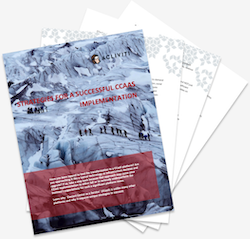There are many contact center benefits that make the case for moving a call center to the cloud. For example, a business can show customer appreciation in a variety of ways. Some institute loyalty programs, others send a coupon or gift basket, but these are short-term solutions. A long-term, lasting customer appreciation strategy that works should be focused on improving customer service year-round. Traditional call center services fail to meet the needs of today’s customers, often proving to be frustrating and unsatisfactory. But transforming a call center into a modern, omnichannel contact center improves the customer experience every day, for long-term, lasting impact.
A contact center as a service (CCaaS) transformation involves a lot of strategy and coordination, and can often seem a bit overwhelming at the start.
The benefits of CCaaS include:
1. Speed and convenience
90% of people surveyed say that they need an immediate response to customer service questions1. But legacy contact centers – particularly voice-based systems – involve waiting on hold and explaining your problems repeatedly to multiple agents, a frustrating experience for customers.
A CCaaS transformation improves response time in several ways. When customers have self-service options, they can often find answers to their questions on their own. Self-service options can be available 24/7 and offer immediate resolution to customer issues. Moreover, if a customer can resolve simple questions without agent intervention, agents have more time to focus on higher-level, strategic objectives.
Omnichannel CCaaS transformations allow customers to select their preferred method of reaching customer agents, further streamlining and speeding the customer service process. Not only does this support faster response time, but it also supports the 24/7 access to service that customers expect.
Additionally, CCaaS improves data integration across multiple channels so that customer interactions and data are updated in real time and available to agents. This eliminates the frustrating experience of continually restating and explaining an issue to different agents, improving response time and meeting customer expectations simultaneously.
Related Reading: Why Do CCaaS Implementations Fail?
2. Agent experience
Most CCaaS transformations start with the general goal of improving customer experience in mind. But improving the contact center benefits agents as well. A cloud-based contact center supports remote work, improving access to flex time and work-life balance for agents. CCaaS also allows automation of manual, repetitive tasks, so that agents can channel their time and effort toward training, strategy, and innovation – increasing overall job satisfaction across the contact center.
CCaaS also improves knowledge management, providing agents the information that they need to have a satisfactory, positive experience with every customer contact. It gives them the tools and resources needed to provide the best possible response, even using real-time analytics.
Providing multiple channels in addition to voice improves the agent experience as well, allowing them to choose between types of contact, adding variety to their experience and providing mental ‘breathing room’ for agents when needed.
And to the company’s benefit: happier employees are more productive and they tend to stick around longer, reducing turnover costs and related recruiting and training costs for new employees.
3. Analytics Capabilities
Legacy technologies are difficult to integrate, and rarely optimized to enable data gathering and analysis across different solutions. But upgrading the contact center benefits companies as they integrate various channels and gather data, which can then be used for valuable insights.
Analytics can be accessed through CCaaS and utilized to create valuable insights: helping companies identify trends and take advantage of opportunities as they arise. There is a benefit to having all channels integrated into a single platform, boosting those insights and making them easier to consolidate.
Strategies for a Successful CCaaS Implementation
Get the Whitepaper
4. Cost Savings
In addition to boosting employee productivity and reducing turnover, a CCaaS transformation helps businesses to save costs in other ways. This may seem counterintuitive, as CCaaS represents a large investment at the outset. However, once implemented, CCaaS helps companies control costs through:
Lower cost per contact: Technologies like chat, self-service, and automated routing helps companies to serve more customers, faster, with fewer agents.
Fewer expenses: Cloud-based technologies require fewer investments in capital expenses like hardware and telecommunications. Operating costs, like hardware maintenance, are also reduced, as are unplanned expenses like unplanned outages and repairs.
Reduced downtime: CCaaS solutions can be designed for redundancy so that in the event of a connectivity issue calls are re-routed and downtime is minimized. Customer service is maintained and the cost of downtime is reduced or eliminated.
Related Reading: The Opportunity Cost of Delaying Modernization
5. Scalability
In a traditional call center, the only way to accommodate business growth is to add more people, more phone lines, more computers. But a CCaaS solution can be infinitely scalable, making it easy to add new services and accommodate customer growth.
Moreover, in a rapidly-changing environment, CCaaS helps businesses to respond to customer needs with agility. Whether dealing with a predictable, seasonal change in demand or an unpredictable, emergency spike in contact, a CCaaS solution helps businesses ensure that they are available to resolve customer issues whenever necessary
A CCaaS transformation project takes a lot of effort – but so does maintaining legacy customer contact center solutions. And the benefits of CCaaS can be enormous: improving results for customers, agents, and the business as a whole. If you are considering, or in the midst of a CCaaS modernization, ACLIVITI can help. Leverage our experience with successful contact center transformation to make the most of your project: building alignment, optimizing strategy, and accelerating results.













